A History of the County of Northampton: Volume 4. Originally published by Victoria County History, London, 1937.
This free content was digitised by double rekeying. All rights reserved.
'Parishes: Isham', in A History of the County of Northampton: Volume 4, (London, 1937) pp. 188-195. British History Online https://www.british-history.ac.uk/vch/northants/vol4/pp188-195 [accessed 20 April 2024]
In this section
ISHAM
Hysham, Hicham, Ysham (xi cent.).
Isham, divided into Upper and Lower, is on the road from Kettering to Wellingborough, the village lying along a branch road. The Ise Brook forms its eastern boundary and separates it from Burton Latimer, in which parish the local station, on the main line of the L.M.S. railway, is situated. Pytchley lies to the north, and to the south and west Little Harrowden.
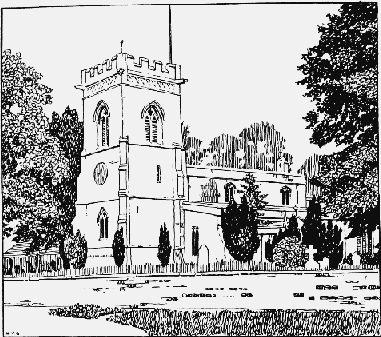
Isham: The Church
The village, which is less than half a mile south of the station, has the church of St. Peter at its centre. The rectory lies to the west of the church, and to the south of it is the smithy. When Bridges wrote there were two rectory houses for the two rectors of Upper and Lower Isham; and a house near the church had medieval features. Attached to a farm west of the church is a rectangular dovecote built of local limestone and covered with red pantiles. It appears to be of 17th-century date, though the massive oak door-frame and door may be earlier: there are 580 nesting holes. (fn. 1) A house standing back from the road to the north of the church is dated 1668. The Manor Farm is at the south-western limit of the village: at its north-eastern end is the school (public elementary), built in 1840 and enlarged in 1875–6 for 100 children: near by are the Corn Mill and the Methodist chapel. Isham Lodge is in the extreme south of the parish.
Its population was 247 in 1801; in 1871 it was 456; and in 1931 it was 365. It lies mostly at a height of 150–250 ft. and has an area of 1,401 acres. The soil is of a good fertile mixed character: subsoil Great Oolite and limestone, sand and ironstone. The chief crops grown are cereals.
Manors
A manor corresponding to Upper Isham apparently, since its chief messuage was later known as the OVER HALL, originated in 1 hide and 2½ virgates of land in Isham (on which was a mill rendering 10s.) held of Guy de Reinbuedcurt by Ralf; of which land the Bishop of Coutances claimed 1½ virgates and 3 small gardens. It had been held freely before the Conquest by Elwin son of Ulf, its value having risen from 5s. to 40s. (fn. 2) There were also 3 virgates in Isham held by Walchelin of the Bishop of Coutances and previously held with sac and soc by Burred, the bishop's predecessor in other properties. (fn. 3) After the bishop had forfeited his lands in the county, his Isham virgates appear to have been included with the Reinbuedcurt lands, in 2⅓ hides in Isham held in the 12th century by Henry de Isham of the fee of Daundevill. (fn. 4) A fee in Isham was held by Henry de Isham in 1235 among the fees that Christiane Ledet had inherited from Guy; (fn. 5) and 1¾ hides in Isham were in 1284 held by Henry de Isham of Alexander Daundewy(l)e, as mesne lord, under William Latimer, (fn. 6) the successor of Guy de Reinbuedcurt in the barony of Wardon. This barony paid for castle guard to Rockingham at the rate of 5s. for each knight's fee, (fn. 7) and Isham is entered in an account of about 1170 as paying 5s. guard money to the castle. (fn. 8)
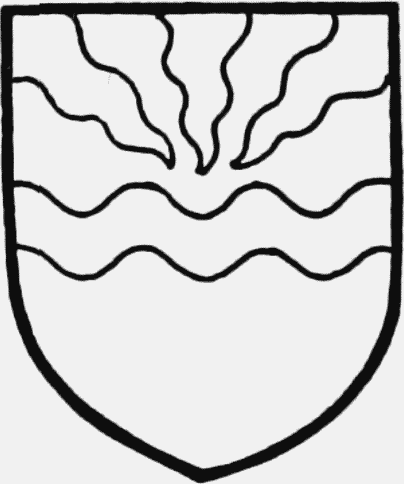
Isham. Gules a fesse wavy argent with three piles wavy argent pointing to the fesse point.
It was pointed out in Northamptonshire Families (fn. 9) that the family of Isham, who appear as tenants at so early a date in this property, has probably dwelt in the county longer than any other family mentioned in that volume. Henry son of Henry de Isham presented to the church in 1236, (fn. 10) and in 1239 was making grants of land here to Elias and James, sons of Henry, presumably his brothers. (fn. 11) He had died before 1249, when the presentation was made by the guardian of the heir of Henry de Isham on account of the minority of this heir. (fn. 12) Isham was in 1283 held by Henry son of Henry de Isham. (fn. 13) From about this time the Ishams seem also to have used the name of L'Isle (de Insula), as in 1300, when Henry de L'Isle demanded from Henry son of Richard atte Hallepace services for whose performance the latter alleged William son of James of Isham to be responsible; (fn. 14) but in 1307 Robert de Ho and Beatrice his wife, who had apparently succeeded to the mesne lordship, granted to Walter de Langeton, Bishop of Coventry and Lichfield, a knight's fee in Isham with the homage and services of Henry de Isham and his heirs for the tenement he held of them. (fn. 15) The presentation to the church was made in 1307 by Henry de Isham, in 1314 by Henry de L'Isle of Isham, and in 1315 by William de L'Isle, lord of Isham, (fn. 16) while in 1316 William de L'Isle was returned as holding Isham, (fn. 17) and in 1317 William de Isham and Alice his wife settled the manor and advowson upon themselves and on the right heirs of William, (fn. 18) to hold of the chief lords of the fee, and William de L'Isle presented in 1341. Other Ishams at this date were described as of Northampton, (fn. 19) or of Pytchley, (fn. 20) and the original Ishams had probably transferred their rights in Isham to a member of the L'Isle family by marriage. Thomas de L'Isle of Isham made a grant in 1336 to William de la Carnell of Earls Barton of the manor of Isham for life, (fn. 21) and in 1341 presentation to the church was made by William de L'Isle, evidently the successor of Thomas, and apparently the last de L'Isle to hold this fee of Isham, since the presentation was in 1349 made by Robert de Wyk, lord of Isham. (fn. 22) Robert de Wyk had died before 1362–3, when John, son of Thomas Caumbery de Bernak, and his wife Elizabeth conveyed the manor of Isham to Katharine, widow of Robert de Wyk of Staunford. (fn. 23) It appears possible that Katharine had been the widow of William de L'Isle before she married Robert de Wyk, and that Elizabeth was William's daughter. In 1365 the presentation was made by the same John, son of Thomas Bernak. (fn. 24) Elizabeth Bernak presented to the church in 1404, and William Bernak in 1437. He was probably the son of Elizabeth, and identical with the William Bernak referred to in the assessment of 1428, which returned that no tax was due from the fee in Isham formerly held by William de L'Isle, because the said fee was divided between Simon Felbrygge [the husband of the widow of Ralf Green], Thomas Green, Thomas Colpepir, William Haldenby, Richard Wynter, William Bernak, and others severally. (fn. 25) The chief manor had, however, evidently remained in the hands of the Bernaks, as in 1448 the presentation was made by John Cooke of Isham, who is shown to have been acting as feoffee of William Bernak in Chancery proceedings instituted against him in that capacity by Thomas Bernak of Barnack, kinsman of William, (fn. 26) and by Walter Dorant of Clyff and Margaret his wife, daughter of William Bernak. (fn. 27) William Bernak left two daughters as his co-heirs, (fn. 28) and in 1454 John Cooke of Isham delivered one-half of the manor and advowson to John Dorant, and the other half to Richard Armeston. (fn. 29) John Dorant presented to the church in 1465, and Richard Armeston in 1477. Between the two presentations John Dorant or Darraunt, described as of Colleyweston, yeoman, had forfeited his moiety of the manor and advowson to the king by attainder of high treason, (fn. 30) and this moiety was on 7 March 1479 granted to Guy Walston, one of the Esquires of the King's Body. (fn. 31) It reverted to the Dorant family, and in 1515 Ralph Sacheverell and Cecily his wife, daughter and heir of John Dorant, conveyed to Sir Richard Sacheverell a moiety of the manor, (fn. 32) which had evidently been in his hands as early as 1502, when Ralph Sacheverell presented to the church.
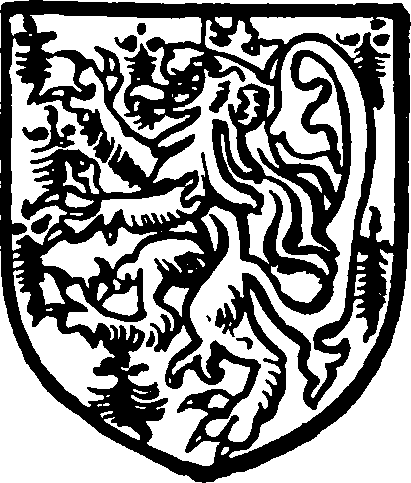
Pickering. Ermine a lion azure crowned or.
The previous presentation, namely that of 1497, was made by John Lowick (or Luffwick) who seems to have been the son by her first husband of Agnes daughter of William Bernak. (fn. 33) John Lowick's daughter and heir Margaret married Robert Pickering of Isham, the son of Thomas Pickering of Barrow Hall in Kendal. They had a son Thomas who married Margaret daughter and heir of Anthony Shuckborough of Little Harrowden and is described as nephew and heir of Anthony Lowick. (fn. 34) This Thomas it was, apparently, who presented to the church in 1554, and who was dealing in 1599 with a moiety of the advowson, which he then conveyed, probably for settlement on his son John, to Thomas Mulsho and Thomas Shuckborough. (fn. 35) After bequeathing his mansion house in Isham called the Over Hall to his son John by will, he died seised of a moiety of the manor and of the advowson called the Over Fee on 1 April 1609, leaving a son and heir Robert aged 40. (fn. 36) John Pickering of Isham was the third son of his father Thomas and married Patience Spicer, according to the Visitation pedigree, which gives him a family of four daughters and no sons. In 1637 John Pickering and Patience his wife conveyed to trustees all his lands in Isham, including the reversion and remainder of the Over Hall, immediately after the death of Sara Weldon, then wife of Robert Weldon, clerk, and late wife of Thomas Pickering, deceased, father of the said John. (fn. 37) Two years later the manor appears to have been held by the Ekins family, who were dealing with it between 1639 and 1658. (fn. 38) The transactions between John Pickering and John Ekins figure in the accounts of the High Commission Court, before which John Ekins of Isham was summoned in 1634 on a charge of irreverent behaviour in church, 'causing to be told over upon the communion table and tendering to the use of John Pickering £100 in performance of a bargain for houses and lands', of sitting with his hat on during divine service, saying in the streets of Isham that a ploughman was as good as a priest, &C. (fn. 39) John Ekins was fined £100, this fine being reduced in 1635 to £20. (fn. 40) It is interesting to note that the decree ordering him to pay this fine and to make submission in Isham Church was procured against John Ekins by Robert Weldon, rector of Stony Stanton. John Ekins succeeded in 1641 in obtaining relief from this decree and in recovering damages, Robert Weldon praying to be excused from personal attendance when Ekins's petition for relief was heard. (fn. 41) It seems possible that Robert Weldon may have had personal reasons for objecting to the transactions between John Pickering and John Ekins more weighty even than his objections to the manner and place of the above payment.
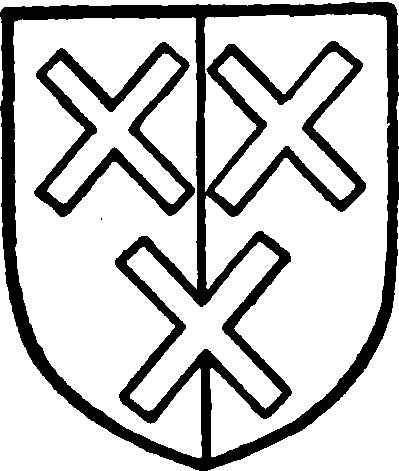
Lane. Party gules and azure three saltires argent.
The moiety of this manor held in 1575 by the Sacheverells appears to have passed to the Lanes, who were already holding lands in Isham in 1502, William Lane dying in that year seised of a toft and a virgate of land there held of Sir Nicholas Vaux, in which he was succeeded by his son and heir Ralph, aged 36. (fn. 42) After Ralph Sacheverell presented in 1502 the presentation was next made by the king by reason of the minority of Robert son of Sir Ralph Lane, who may be assumed therefore to have held a moiety of the Bernak inheritance. Owing to the sales and subdivisions indicated in the assessment of 1428 it is not easy to distinguish the manors of Isham in the 15th–16th centuries, but Sir Robert Lane subsequently transferred a manor of Isham which was probably this moiety to the Lanes of Kettering, by whom a manor of Isham was held which had its origin in lands, part of the L'Isle fee of Isham, originally held by a branch of the Green family, from whom it had come to them through the Culpeppers and Harringtons. Three branches of the Green family were represented in 1428 among the tenants of the fee of William de L'Isle in Isham, and they had held lands there for some time. 'Henry del Grene of Isham' was in 1337 appointed to buy wool in the county of Northampton (fn. 43) and in 1337, 1338, 1343, (fn. 44) and subsequent years received allowances of wool, &c. Simon Felbrigge in 1428, in right of his wife, held the lands of these Greens of Isham. (fn. 45) Thomas Green, who was described as of Isham in 1339 when Richard de Toryngton of Berkhamstede acknowledged a debt to him of £200, was the predecessor of Sir Thomas Green who died seised of a manor of Isham in 1420 and was succeeded by Thomas Green his son and heir, (fn. 46) who held in 1428. Nicholas Green of Isham, who in 1350 witnessed a grant by Sir Robert de Morlee of lands in Wellingborough, (fn. 47) was the owner of lands which in 1428 appeared in the hands of Sir Thomas Colpeper in Isham, and which were later held by the Lanes of Kettering. On 14 February 1367 Athelina or Alana de Bruys quitclaimed to Nicholas Green and his wife Joan the manors of Exton (co. Rutland) and Conington (co. Huntingdon) in a deed dated at Isham. (fn. 48) In 1378 Sir Thomas Colepeper and his wife Eleanor, who was the daughter and heir of Nicholas Green (fn. 49), acquired all the lands of the said Nicholas in Isham, Pytchley, and elsewhere in Northamptonshire. (fn. 50) Sir Thomas Colepeper appeared in 1428 as one of the tenants among whom the fee of William de L'Isle was divided, and in 1433 (fn. 51) a manor of Isham was in the hands of his son Sir John Colepeper, who with his wife Juliana then made a conveyance of it with the manors of Exton and Conington. This manor of Isham was in 1513 settled by John Harrington of Exton, son of Katharine daughter of Sir John Colepeper, (fn. 52) and his wife Alice, on their son John at his marriage with Elizabeth Mutton. (fn. 53) This manor was described at the inquisition taken on 20 October 1524 after the death of John Harrington the elder on 6 November 1523 as held of Thomas, Lord Vaux of Harrowden, who had inherited the estates of Thomas Green, as of his manor of Harrowden. (fn. 54) In 1541 John Harrington and James his son and heir conveyed the manor of Isham to John Lane and Elizabeth his wife. (fn. 55) This was John Lane of Kettering, who in the inquisition taken after his death on 8 March 1546 was stated to have bequeathed a life interest in the same to his wife Elizabeth, who survived him, with remainders to his son and heir John, his two daughters, to John Lane of Walgrave, to the latter's brother William Lane, to Ralph Lane second brother of Robert Lane, a younger son of Sir Ralph Lane, deceased, to William Lane third brother of the said Robert, and to the testator's brother George Lane, in tail male. (fn. 56) It was apparently not this manor, but the manor which he had inherited from his father Sir Ralph, of which Sir Robert Lane made a conveyance in 1558 to Elizabeth Lane, widow, and John Lane her son. (fn. 57) John Lane of Kettering presented to the church in 1561 and had died before 1576 leaving a son and heir Basil, and the Lanes still held the manor in 1616, in which year David Lane was dealing with it by fine. (fn. 58)
The presentations to the Upper Fee suggest that this manor (or moiety) may have been held in 1637 by William Hodges of Daventry who then presented. (fn. 59) Apparently this manor in 1712 was in the hands of John Allicocke of Loddington (son and heir of Thomas Allicocke of Sibbertoft), who with his wife Elizabeth, daughter and heir of Moses Bathurst, formerly of Hothorpe, and their son Benjamin Allicocke, was then dealing with the manors of Loddington and Isham. (fn. 60) Bridges wrote that the manor was in dispute between the Allicockes, who had a good estate in Isham (several farm-houses with 3, 4, and 5 yardlands are mentioned in this deed of 1712), and the daughters of Lady Robinson. (fn. 61)
A part of the manor of Isham was in 1778 in the hands of Brook Bridges, clerk, and Anne his wife, who sold to George Huggit, clerk; (fn. 62) the latter appears as an owner of lands in the parish in the Inclosure Act passed for the parish in that year, and John, Earl of Upper Ossory as lord of the manor (fn. 63) (possibly the manor held of the Huntingdon fee). By the same Act an allotment was made to John Harper, esq. The Harpers had before 1803 acquired the manorial rights of Isham, of which manor Joseph Harper, the successor of his cousin John Harper in the manor of Burton Latimer or Plassy, then levied a fine. (fn. 64) Thomas Wilfred Harpur (fn. 65) of Burton Latimer died in 1934, and his son Captain John Latimer Harpur now holds land in Isham, but does not claim manorial rights. (fn. 66)
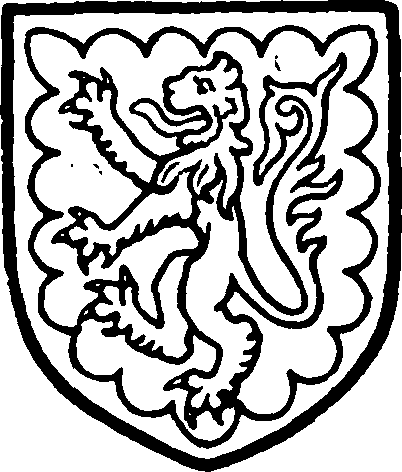
Harper. Argent a lion in a border engrailed sable.
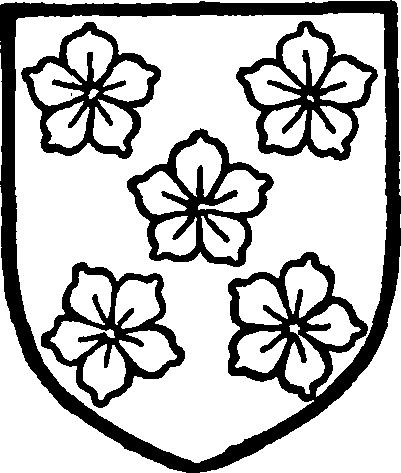
Haldenby. Azure five cinqfoils set saltirewise argent.
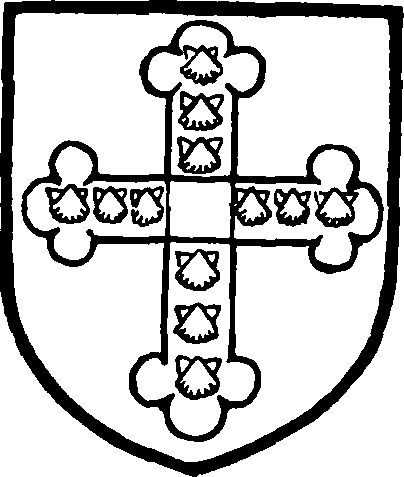
Humfrey. Gules a cross with trefoil ends and quarter-pierced argent charged with twelve scallops sable.
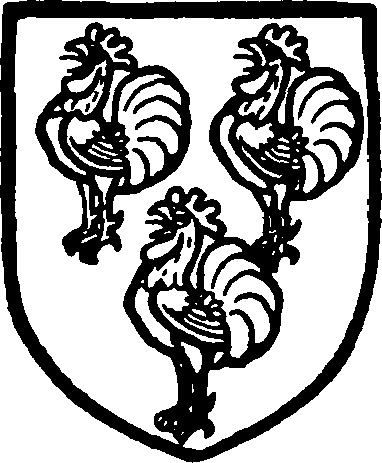
Cockayne. Argent three cocks gules.
Six small virgates in Isham were entered in the Northampton Survey as held by Geoffrey of the fee of Huntingdon, (fn. 67) though in the Domesday Survey no lands were entered as held in Isham by the Countess Judith. They must have been the origin of the manor of Isham which was afterwards returned with Little Harrowden as a member of Great Harrowden, and was later known as HALDENBY'S MANOR or the MANOR OF HOLDENBY in Isham and, as previously stated, probably corresponded to Lower Isham or a fee called the Lower Fee. In 1235 half a fee in Clipston and Isham was held of the fee of Huntingdon by Simon 'Major'. (fn. 68) From the Quo Warranto returns in 1329–30 it appears that the manor of Great Harrowden with its members Little Harrowden and Isham were given by Robert de Muschamp to Geoffrey de Lewknor, from whom this property descended to his son and heir Ralph. (fn. 69) This Isham manor descended as a member of Great Harrowden (q.v.) until the 15th century. In 1411 Maud wife of Robert Haldenby granted to John Haldenby her son a rent of half a pound of pepper from the manor of Isham. (fn. 70) William de Haldenby of Isham appears in 1428 as holding lands in Wollaston, (fn. 71) and had evidently succeeded to this Isham manor. The Haldenbys still held the manor in 1475, when William Haldenby of Isham, gentleman, was cited in a plea of debt to Thomas Pomeroy, prior of Holy Trinity, London, executor of the will of William Lemyng, late citizen and grocer of London. (fn. 72) In 1546 William Haldenby made a conveyance to Richard Humfrey of the manor of Haldenby and advowson of the church of the parish of Isham of the Lower Fee, with a dovecot, a water mill and lands. (fn. 73) The manor remained in the hands of the Humfreys and was at a later date held by William Humfrey of Barton Segrave; after whose death his son Thomas Humfrey of Swepston (co. Leicester) instituted Chancery proceedings (fn. 74) to recover possession of the manor of Isham commonly called Haldenbyes Manor, with one water corn-mill, one fulling-mill, and appurtenances in Isham, and lands elsewhere, all of which had been settled on him, he alleged, about 34 years before by William Humfrey, whose second son he was. That this property was held of the Vaux by the Cecils in succession to the Humfreys may be inferred from one of those letters that Sir Thomas Tresham wrote to his wife at Rushton from his long and close imprisonment for recusancy. On All Saints' Day 1594 he wrote to Lady Tresham (fn. 75) of his return to London after a temporary release: 'I alighted in Holborne, and going down Chancery Lane to my lawyer's I met Mr. Frampton, the chief manager of Sir Thomas Cecill's affairs, who begged me to go to his master, Sir Thomas, as having, he declared, been most badly dealt with by the Lord Vaux: for the widow interrupted his master's possession of Isham lands.' William, Lord Vaux of Harrowden, with his wife Mary conveyed the manor of Isham in 1595 to Richard Frampton and John Wyseman, (fn. 76) to whom in the following year another conveyance of the same was made by Sir Thomas Cecil and his wife Dorothy. (fn. 77) This presumably eliminated the overlordship and was followed in 1599 by a grant of the manor of Isham to Robert Syers by John Wyseman and Margery his wife, and Richard Frampton. (fn. 78) It was found by inquisition of 1608 that Robert Syers, who had absented himself from church, was possessed for life of the manor and chief messuage in Isham and Little Harrowden in the tenure of several persons, and a grant of two parts of the manor was made on 9 July 1609 to Edward Heselrigge. (fn. 79) Robert Syers made a settlement of the manor in 1610 on his son John and daughters Anne and Frances and died on 10 August 1618, leaving a son and heir John aged 12. (fn. 80) It seems then to have been acquired by Sir William Cockayne, who died seised of it in 1627–8, when it was returned as held with 2 watermills, &c, of the king as of the manor of Holdenby. (fn. 81) Sir William was succeeded by his son Charles, who in 1629, with his wife Mary, and Mary Cockayne, widow, William Chayne, Matthew Cradock, Thomas Henchman, and James Price, made a conveyance by fine to Sir Hatton Farmer and William Allen of the manors of Rushton and of Holdenby in Isham. (fn. 82) Though lands in Isham were held by the Cockaynes with their manor of Rushton as late as the 19th century, conveyances of the same being made by Barbara M. Cockayne, spinster, in 1810–11, (fn. 83) and by Elizabeth C. Cockayne, spinster, in 1821, (fn. 84) Holdenby Manor was probably held before 1660–2 by Robert Guy, who in those years presented to the church. The manor of Holdenby and half the advowson of Upper Isham were in 1686 in the hands of Francis Guy and his wife Elizabeth who conveyed it to Thomas Colthurst and Jonathan Gorstelow Snow. (fn. 85) In 1745 Holdenby's manor was conveyed by James Langley and his wife Anne, Thomas Cannell and his wife Mary, and John Harriss and his wife Elizabeth, to George Timms, clerk, (fn. 86) after which its history becomes obscure.
The Ramsey Chronicle shows that a manor in Isham was held in Saxon times by Earl Brithnoth, whom the chronicler describes as 'that generous benefactor of the abbey, foremost among his countrymen in honour and wealth, and for his valour in fighting against the foes of his country', and who gave his two manors of Isham and Whiston and a hide in Doddington to the abbey. (fn. 87) Isham was confirmed to the abbey by King Edgar in 974 (fn. 88) (among the witnesses being Earl Brithnoth) by Edward the Confessor (1052–60), (fn. 89) and by succeeding kings. (fn. 90) But for a time the grasping sheriff Eustace succeeded in ousting the abbey from its property, which was entered in the Domesday Survey among the lands of Eustace, Sheriff of Huntingdonshire, who held of the king 1 hide and 2½ virgates of land in Isham which it was stated he had occupied by force, wronging the church of Ramsey. (fn. 91) William II restored this property to the abbey, after an inquiry had been ordered by him, (fn. 92) of which an account is given in a previous volume. (fn. 93)
A hidage of the knights of the abbey of 1184–9 gives Niel de Lovetot as tenant of 1½ hides in Isham, for which apparently he owed, in conjunction with Henry de Withenton, who held 3½ (or 4) hides in Whiston, the service of one knight. (fn. 94) Another hidage of about fifty years later, confirming the Northampton Survey, which enters Thomas Pyel as holding 1½ hides and 2½ small virgates of the fee of Ramsey, (fn. 95) gives Thomas Pyel as tenant of 1½ hides. (fn. 96) One Henry Pyel in 1240 levied a fine with Henry son of Henry (probably Henry de Isham) of 2 virgates of land in Isham, (fn. 97) and in 1253, as Henry Pyel of Isham, received from William de Brampton and Juliana his wife a messuage and half a virgate of land there. (fn. 98) But the holder of the fee in 1243–4 was Thomas Pyel, who paid a fine of half a mark because of the insufficiency of his horse to perform service in Scotland. (fn. 99) In 1257, an inquiry was held at the abbot's court at Broughton, at which Thomas Pyel was personally present, to establish the nature of the service due from him for the fee of Pyel of Isham, and it was found that he ought to find a nag equipped to carry the armour of four knights on every journey of the said knights made by them in the king's service, i.e. for a possible 40 days in the year. (fn. 100)
The Pyel fee had in 1278 passed to the Carnells or Kernels, (fn. 101) and was held by William de la Carnell of Isham who came into full court at Broughton in that year with a horse worth 10s., a sumpter saddle worth 12d., a sack worth 6d., and a 'broche', and after offering himself for the service due to the king from him was given a day to return when summoned. (fn. 102) In 1284 William de la Carnell was assessed for 1¼ hides in Isham which he held of the Abbot of Ramsey. (fn. 103) That the Carnells continued to hold land in Isham is shewn by a reference in 1382 to John Carnell of Isham whose box of muniments and charters John Gunmyll of Tixover had retained: (fn. 104) he was possibly identical with the John Carnell who was escheator for the county.
The abbots of Ramsey were no longer holding in Isham at the Dissolution, and it would seem that they parted with the estate to the Earl of Gloucester about the end of the 13th century, as William Pyel was holding a moiety of a fee in Isham of Gilbert de Clare, Earl of Gloucester and Hertford, at his death in 1314, (fn. 105) and this half-fee, valued at 30s. yearly, was delivered to Maud the widow of Gilbert in dower. (fn. 106) Moreover, land in Isham held by John Carnell was included in 1387 among the fees held of Hugh, Earl of Stafford, at his death, (fn. 107) and in 1403 among those held of Edmund, Earl of Stafford. (fn. 108)
The Pyels still held lands in Isham in 1398–9, (fn. 109) when Elizabeth Pyel, daughter and heir of Henry Pyel late burgess of Bristol, made a conveyance of the same to her cousin John Sutton of Bristol.
The temporalities of the priory of Huntingdon at the Dissolution included the farm of a croft in Isham, i.e. 6s. 4d. (fn. 110) A moiety of this croft, in the tenure of the rector, was granted to Giles and Gregory Isham in 1546 with half a virgate of land. (fn. 111) A rent of 26s. 8d. in Isham was held by the priory of St. Andrew's (Northampton) at the Dissolution. (fn. 112)
Church
The church of ST. PETER consists of chancel, 28 ft. 4 in. by 14ft. 4 in.; clerestoried nave of three bays, 39 ft. by 13 ft. 10 in.; north and south aisles, 12 ft. wide, north and south porches, and west tower, 10ft. 6 in. square, all these measurements being internal. The aisles are the full length of the nave, and are continued eastward, covering the chancel about half its length. There is a sanctus bell-cote on the east gable of the nave over the chancel arch.
The church is built throughout of rubble with ashlar dressings, and, except in the north aisle, has plain parapets and low-pitched leaded roofs: the lead of the north aisle overhangs.
The two western arches of the nave arcades date from c. 1180 and probably represent the full extent of the nave of a small 12th-century church with narrow aisles and a square-ended chancel. In the first half of the 13th century the church was practically rebuilt, the nave being extended a bay eastward and a new chancel erected, while later in the same century the aisles were widened and carried eastward to their present extent. A west tower also appears to have been built, or intended, at this time, as the tower arch is of the same period as the chancel, but the existing tower is of 14th-century date, as are also the clerestory and north doorway. In 1870 the building was extensively restored, the south porch being rebuilt on the old foundation, a north porch added, the chancel reroofed, (fn. 113) a west gallery taken down, and the tower arch opened out. Several of the aisle windows were renewed at this time: they are said not to reproduce those they replaced, but one in the north aisle and two in the south are of 14th-century date, and the east window of the south aisle is a 15th-century insertion.
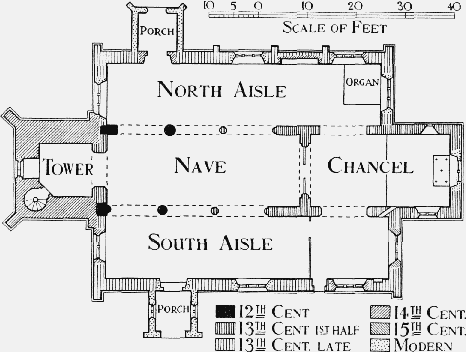
Plan of Isham Church
The chancel is without buttresses and has an east window of two lights with forked mullion: the window is comparatively modern, apparently replacing a group of three lancets, two or three of the upper jambstones of which are still in position. In the north wall is a 13th-century lancet, and in the south wall a tall two-light window with forked mullion, the lower part of which is cut off by a transom so as to form two small oblong openings, that to the west being used as a low-side window. (fn. 114) This window is of late-13th-century date, its sill forms a seat, but no piscina remains. In the north wall is a rectangular recess with splayed jambs and head. The western part of the chancel is open on each side to the aisles by a pointed arch of a single chamfered order, and the 13th-century chancel arch is of two chamfered orders, the inner springing from half-octagonal responds with moulded capitals. The doorway to the rood-loft remains on the north side west of the chancel arch, its sill being only 7 ft. 4 in. above the nave floor, but it is blocked towards the aisle, and the steps have disappeared.
The nave arcades differ in detail, though the two 12th-century western arches on each side are semicircular and the easternmost arch pointed. On the north the round arches are of a single square order and spring from a square respond with quirked and chamfered impost and a cylindrical pier with moulded base and scalloped capital, the square abacus of which corresponds with the impost moulding. The arcade on the south side is slightly later, the capitals of both respond and pier being carved and the arches of two square orders with hood-mould on each side. The respond is a half round with moulded base and early leaf-ornament below the quirked abacus, and the capital of the circular pier has a head at each angle with foliage issuing from the mouth. The second pier from the west on each side belongs to the 13th-century extension and carries both a round and a pointed arch; the pointed arches are of two chamfered orders without hoodmoulds and the piers are octagonal with moulded capitals and chamfered bases. The clerestory has two pointed windows on each side, and the nave roof is a modern one of four bays.
A scroll moulding runs the entire length of both aisles at sill level, and is continued round the buttresses, but above this the walls may have been rebuilt. In the north wall of the north aisle, between the first and second windows from the east, is a wide 14thcentury ogee-headed recess with moulded arch and crocketed hood-mould with finial and side pinnacles. The hollow moulding of the label is ornamented with the ball-flower, and at the back of the recess, returned on either side, is a band of quatrefoils. The sill is 3 ft. 7 in. above the floor, but the recess contains no monument of any sort. The east end of the south aisle, formerly a chapel, is partitioned off by a modern screen to form a vestry: in the usual position in the south wall is a trefoil-headed piscina with fluted bowl and stone shelf, and at the east end of the north wall a squint to the chancel which is rebated top and bottom for a shutter. The 15th-century east window is four-centred and of three cinquefoiled lights: (fn. 115) in the wall to the south of it is a plain image-bracket and to the north an inserted fragment of a grave-slab with incised cross. There is a late-13th-century doorway in the south wall with chamfered cinquefoiled arch and east of it a square-headed window of three trefoiled lights.
The 14th-century north doorway of the nave has a continuous moulded pointed arch, with label terminating in heads: the south doorway is modern.
The tower is of three stages with diagonal angle buttresses and battlemented parapet, below which is a band of lozenge quatrefoils. The walls slightly batter, and the bell-chamber windows are of two cinquefoiled lights with a quatrefoil in the head. There is a vice in the south-west angle, and a west window of two lights in the lower stage. The lofty tower arch is of two chamfered orders, the inner springing from half-octagonal responds with moulded capitals and chamfered bases.
The font is ancient and consists of a plain octagonal bowl and stem on a chamfered base.
The oak pulpit, c. 1600, has panelled sides and back and a modern canopy. (fn. 116) The upper panels are carved with winged heads and the back with a winged and crowned female figure holding orb and sceptre. (fn. 117)
The lower part of a 15th-century oak chancel screen remains in position, cut down to rail level. It has two traceried panels on each side of the opening and the rail is carved. Part of the stalling is made up of woodwork of the same type and period. The altar rails are Jacobean, with turned balusters.
In the chancel floor is a large slab on which was formerly the brass of Sir John Boyvyle (1493), but the figure and four shields of arms have disappeared. (fn. 118) The inscription remains. (fn. 119) There are no other monuments earlier than 1800.
There is a ring of six bells cast by Taylor & Co. of Loughborough in 1906 from an old ring of four, to which two trebles were added. (fn. 120)
The plate consists of a silver cup and cover paten c. 1680, a silver bread-holder of 1683, a pewter flagon, and a brass alms dish. (fn. 121)
The registers before 1812 are as follows: (i) baptisms and burials 1701–1805, marriages 1701–54; (ii) marriages 1754–1812; (iii) baptisms and burials 1806–12. (fn. 122)
Advowson
The church was valued in 1291 in two portions. These were held by two rectors as the Upper and the Lower Fee, each portion being worth £5, with pension deducted. (fn. 123) The pension was that of the Abbot of St. Andrew's (Northampton), returned in Valor Ecclesiasticus as 13s. 4d. The combined rectories were valued in the Valor at £16 13s. 8d., the rectory of Upper Isham being returned as worth £7 10s. (fn. 124) The rectors of the two portions were called comportioners. The rector of the Lower Fee was in 1634–5 before the High Commission Court for procuring himself to be superinstituted, and resigned his title to the rectory; (fn. 125) and the parish registers show that in 1662 the rector of Lower Isham was removed for 'contending for the Upper Parsonage', when Mr. Galston was presented to both by the Bishop of Lincoln and the king. (fn. 126) But it was not until 1841 that the two portions were consolidated into one benefice by Order in Council, the Bishop of Lincoln being patron. Since the division of the bishopric, the patronage has been in the Bishop of Peterborough.
The advowsons of the rectories of the two portions of Isham church belonged originally apparently to the owners of the manors held respectively of the Latimers and of the Huntingdon fee, that of the Lower Fee having apparently been given (fn. 127) to the priory of Huntingdon, by whom the presentation was made in 1227 (fn. 128) and in 1230. (fn. 129) Though the presentation to the Lower Fee was made in 1235 by St. James's Abbey, (fn. 130) this must have been done by permission of the priory of Huntingdon, by whom the presentation was made in 1238. (fn. 131) Before the close of the 13th century the advowson of this fee was in the hands of the Bishop of Lincoln, and so continued until the union of the two rectories. Though in 1546 William Holdenby included the advowson in the sale of the manor, he does not seem ever to have owned it.
The descent of the advowson of the Over Fee was the same as that of the manor of the Over Hall (q.v.) until 1726, when Francis Hawes and his wife Susan conveyed it with the manor of Kettering to Sir Thomas Crosse, bart., and Matthew Lant. (fn. 132) In 1745 William Franks, clerk, and Anne his wife with Thomas Whitworth and Elizabeth his wife conveyed it to Sir John Dolben, bart., and Langham Rokeby by fine, with warranty against the heirs of Anne and Elizabeth, (fn. 133) and the presentation was made in 1744 and 1749 by Samuel Morton, a minor; in 1752 and 1760 by Anne Franks, widow; and in 1774 by Thomas Rokeby. (fn. 134) In 1804 the advowson was held by William John Lushington and his wife Barbara, who conveyed it by fine to Benjamin Clarke Raworth. (fn. 135) By Order in Council, 21 August 1841, the rectories of Isham Superior and Inferior were united. The patronage of Isham Superior was then in the hands of Sir George Stamp Robinson, from whom the Bishop of Lincoln obtained it in exchange for Cranford St. John, of which church Sir George was rector. The united rectories were transferred to the Bishop of Peterborough in 1852. (fn. 136)
Charities
Church land, Constable's land, and Apprentice land. On the inclosure of the parish in 1774 three allotments in Broadmoor Field were awarded in lieu of lands and rights in the open fields. The property consists of about 30 acres let for £45 yearly, and the invested accumulations of income of the Apprentice lands produce about £5 yearly. About £24 is applied to church expenses, £10 10s. as apprenticeship premium, and £3, from the Constable's land, to public uses. The charity is administered by the vicar and four other trustees.
Ann Green by her will dated 28 August 1829 gave 19 guineas, now producing 10s. yearly, to the minister and churchwardens upon trust to apply the income for the benefit of the Sunday school; and also £40, now producing £1 yearly, to be distributed in bread.
By his will dated 30 March 1829 William Green gave £300 Consols upon trust to apply the income in the distribution of meat to the poor on 24 December. The income of this and the preceding charity is distributed in food by the minister and two trustees appointed by the Parish Council.
By her will proved 2 March 1900 Miss Ann Caroline Ayres gave £40 to the rector, churchwardens, and overseers upon trust to apply the income in the distribution of coals to the poor. The legacy was invested in £41 Consols, producing £1 0s. 4d. yearly in dividends. The several sums of stock are with the Official Trustees of Charitable Funds.
